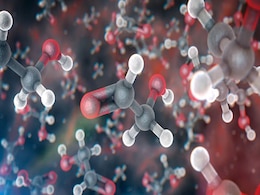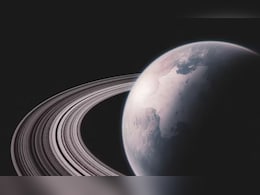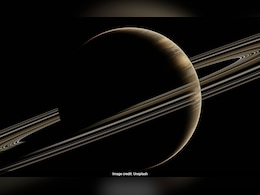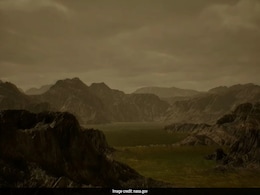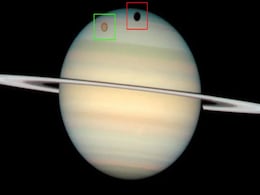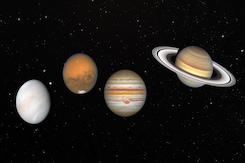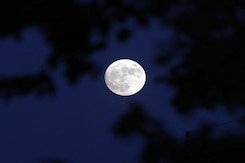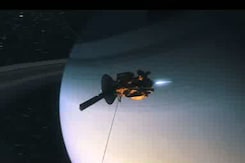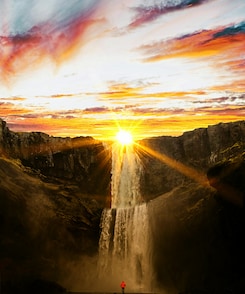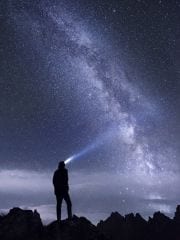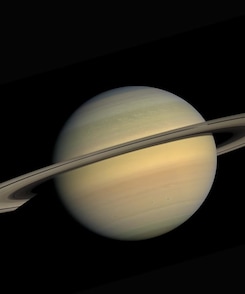Saturn
- All
- News
- Videos
- Web Stories
-

Study Reveals Saturn's "Mimas" Moon Might Have Hidden Boiling Ocean Under Its Ice
- Friday November 28, 2025
- Science | Edited by Astitva Raj
But on larger icy moons, the ice layer may break up before the water boils, preventing the formation of a boiling ocean.
-
 www.ndtv.com
www.ndtv.com
-

From Meteor Showers To Beaver Supermoon, 10 Must-See Celestial Events In November 2025
- Wednesday November 5, 2025
- Science | Edited by Ritu Singh
November skygazing events: The month begins with the Taurid meteor showers, known for producing slow, bright fireballs that light up the sky.
-
 www.ndtv.com
www.ndtv.com
-

Scientists Find Water And Oil Mixing On Saturn's Moon During Simulation, Defying Rules Of Chemistry
- Tuesday November 4, 2025
- Science | Edited by Srishti Singh Sisodia
Researchers simulated Titan's atmosphere and surface conditions in laboratory experiments.
-
 www.ndtv.com
www.ndtv.com
-

Saturn’s Icy Moon Enceladus Organic Molecules May Have Been Fromed by Cosmic Rays, Scientists Find
- Monday October 27, 2025
- Written by Gadgets 360 Staff
Laboratory experiments reveal that radiation striking Saturn’s icy moon Enceladus can create simple organic molecules, reshaping how scientists interpret Cassini’s data and highlighting radiation’s key role in the chemistry of icy moons.
-
 www.gadgets360.com
www.gadgets360.com
-

Saturn’s Moon Titan Breaks One of Chemistry’s Oldest Rules, NASA Study Reveals
- Friday October 24, 2025
- Written by Gadgets 360 Staff
Saturn’s moon Titan has shocked scientists by breaking a key chemistry rule. NASA and Chalmers University researchers found that polar and nonpolar molecules, usually immiscible, can mix under Titan’s extreme cold. The discovery deepens our understanding of prebiotic chemistry and could reveal how life’s building blocks form in frigid extrate...
-
 www.gadgets360.com
www.gadgets360.com
-

Astronomers Observe Rings Forming Around Icy Celestial Body Chiron
- Wednesday October 15, 2025
- World News | Reuters
The rings of Saturn are among the wonders of our solar system, with a diameter of roughly 280,000 kilometres as they encircle the giant planet. But smaller celestial bodies in the solar system also boast ring systems that are impressive in their own.
-
 www.ndtv.com
www.ndtv.com
-

Saturn's Moon Could Be Alien Life's Perfect Home, Reveals Study
- Tuesday October 7, 2025
- Science | Edited by Nikhil Pandey
New analysis of Cassini data reveals complex organic molecules in ice grains from Saturn's moon Enceladus, boosting hopes that its hidden ocean could support alien life.
-
 www.ndtv.com
www.ndtv.com
-

Saturn’s Moon Enceladus Spouts Complex Organics That Could Hold Clues to Life
- Sunday October 5, 2025
- Written by Gadgets 360 Staff
Analysis of Cassini data confirms Saturn’s moon Enceladus emits organic molecules, suggesting its subsurface ocean may harbor chemistry conducive to life.
-
 www.gadgets360.com
www.gadgets360.com
-

James Webb Offers First Glimpse Into How Moons Are Built Around Distant Planets
- Wednesday October 1, 2025
- Written by Gadgets 360 Staff
The James Webb Space Telescope has detected carbon-bearing molecules in a moon-forming disk surrounding CT Cha b, a massive planet-like object orbiting a young star 625 light-years away. The discovery marks the first measurement of its kind and offers clues to how moons like those around Jupiter and Saturn might have formed.
-
 www.gadgets360.com
www.gadgets360.com
-

More Ingredients For Life Discovered In Ocean On Saturn Moon
- Wednesday October 1, 2025
- Science | AFP
The ocean hidden under the icy shell of Saturn's moon Enceladus harbours complex organic molecules, a study said, offering further evidence that the small world could have all the right ingredients to host extraterrestrial life.
-
 www.ndtv.com
www.ndtv.com
-

Study Reveals What Presence Of CO2 On Eight Saturn Moons Means
- Tuesday July 29, 2025
- Science | Edited by Srishti Singh Sisodia
The study aims to help scientists understand the existence of CO2 on planetary bodies, the process of formation and evolution.
-
 www.ndtv.com
www.ndtv.com
-

Did Something Hit Saturn? Astronomers Investigate Possible Impact Flash
- Wednesday July 9, 2025
- Science | Edited by Amit Chaturvedi
Unlike rocky planets where asteroid impacts leave visible craters, gas giants like Saturn have outer layers of hydrogen and helium that can absorb impacts without obvious traces.
-
 www.ndtv.com
www.ndtv.com
-

Rare Titan Shadow Transits Will Sweep Across Saturn in Summer 2025
- Monday June 30, 2025
- Written by Gadgets 360 Staff
In a rare celestial alignment, Saturn’s largest moon Titan will cast its shadow across the planet in a series of stunning transits during the summer and early fall of 2025. These events, visible through telescopes, appear as dark “holes” drifting across Saturn’s face as Titan eclipses the planet. The phenomenon occurs only near Saturn’s e...
-
 www.gadgets360.com
www.gadgets360.com
-

Discovery Of Small Star Giving Birth To Huge Planet Leaves Scientists Puzzled
- Friday June 6, 2025
- Science | Edited by Srishti Singh Sisodia
TOI-6894 is roughly 240 light-years from Earth in the constellation Leo and is the smallest-known star to host a large planet.
-
 www.ndtv.com
www.ndtv.com
-

Study Reveals Saturn's "Mimas" Moon Might Have Hidden Boiling Ocean Under Its Ice
- Friday November 28, 2025
- Science | Edited by Astitva Raj
But on larger icy moons, the ice layer may break up before the water boils, preventing the formation of a boiling ocean.
-
 www.ndtv.com
www.ndtv.com
-

From Meteor Showers To Beaver Supermoon, 10 Must-See Celestial Events In November 2025
- Wednesday November 5, 2025
- Science | Edited by Ritu Singh
November skygazing events: The month begins with the Taurid meteor showers, known for producing slow, bright fireballs that light up the sky.
-
 www.ndtv.com
www.ndtv.com
-

Scientists Find Water And Oil Mixing On Saturn's Moon During Simulation, Defying Rules Of Chemistry
- Tuesday November 4, 2025
- Science | Edited by Srishti Singh Sisodia
Researchers simulated Titan's atmosphere and surface conditions in laboratory experiments.
-
 www.ndtv.com
www.ndtv.com
-

Saturn’s Icy Moon Enceladus Organic Molecules May Have Been Fromed by Cosmic Rays, Scientists Find
- Monday October 27, 2025
- Written by Gadgets 360 Staff
Laboratory experiments reveal that radiation striking Saturn’s icy moon Enceladus can create simple organic molecules, reshaping how scientists interpret Cassini’s data and highlighting radiation’s key role in the chemistry of icy moons.
-
 www.gadgets360.com
www.gadgets360.com
-

Saturn’s Moon Titan Breaks One of Chemistry’s Oldest Rules, NASA Study Reveals
- Friday October 24, 2025
- Written by Gadgets 360 Staff
Saturn’s moon Titan has shocked scientists by breaking a key chemistry rule. NASA and Chalmers University researchers found that polar and nonpolar molecules, usually immiscible, can mix under Titan’s extreme cold. The discovery deepens our understanding of prebiotic chemistry and could reveal how life’s building blocks form in frigid extrate...
-
 www.gadgets360.com
www.gadgets360.com
-

Astronomers Observe Rings Forming Around Icy Celestial Body Chiron
- Wednesday October 15, 2025
- World News | Reuters
The rings of Saturn are among the wonders of our solar system, with a diameter of roughly 280,000 kilometres as they encircle the giant planet. But smaller celestial bodies in the solar system also boast ring systems that are impressive in their own.
-
 www.ndtv.com
www.ndtv.com
-

Saturn's Moon Could Be Alien Life's Perfect Home, Reveals Study
- Tuesday October 7, 2025
- Science | Edited by Nikhil Pandey
New analysis of Cassini data reveals complex organic molecules in ice grains from Saturn's moon Enceladus, boosting hopes that its hidden ocean could support alien life.
-
 www.ndtv.com
www.ndtv.com
-

Saturn’s Moon Enceladus Spouts Complex Organics That Could Hold Clues to Life
- Sunday October 5, 2025
- Written by Gadgets 360 Staff
Analysis of Cassini data confirms Saturn’s moon Enceladus emits organic molecules, suggesting its subsurface ocean may harbor chemistry conducive to life.
-
 www.gadgets360.com
www.gadgets360.com
-

James Webb Offers First Glimpse Into How Moons Are Built Around Distant Planets
- Wednesday October 1, 2025
- Written by Gadgets 360 Staff
The James Webb Space Telescope has detected carbon-bearing molecules in a moon-forming disk surrounding CT Cha b, a massive planet-like object orbiting a young star 625 light-years away. The discovery marks the first measurement of its kind and offers clues to how moons like those around Jupiter and Saturn might have formed.
-
 www.gadgets360.com
www.gadgets360.com
-

More Ingredients For Life Discovered In Ocean On Saturn Moon
- Wednesday October 1, 2025
- Science | AFP
The ocean hidden under the icy shell of Saturn's moon Enceladus harbours complex organic molecules, a study said, offering further evidence that the small world could have all the right ingredients to host extraterrestrial life.
-
 www.ndtv.com
www.ndtv.com
-

Study Reveals What Presence Of CO2 On Eight Saturn Moons Means
- Tuesday July 29, 2025
- Science | Edited by Srishti Singh Sisodia
The study aims to help scientists understand the existence of CO2 on planetary bodies, the process of formation and evolution.
-
 www.ndtv.com
www.ndtv.com
-

Did Something Hit Saturn? Astronomers Investigate Possible Impact Flash
- Wednesday July 9, 2025
- Science | Edited by Amit Chaturvedi
Unlike rocky planets where asteroid impacts leave visible craters, gas giants like Saturn have outer layers of hydrogen and helium that can absorb impacts without obvious traces.
-
 www.ndtv.com
www.ndtv.com
-

Rare Titan Shadow Transits Will Sweep Across Saturn in Summer 2025
- Monday June 30, 2025
- Written by Gadgets 360 Staff
In a rare celestial alignment, Saturn’s largest moon Titan will cast its shadow across the planet in a series of stunning transits during the summer and early fall of 2025. These events, visible through telescopes, appear as dark “holes” drifting across Saturn’s face as Titan eclipses the planet. The phenomenon occurs only near Saturn’s e...
-
 www.gadgets360.com
www.gadgets360.com
-

Discovery Of Small Star Giving Birth To Huge Planet Leaves Scientists Puzzled
- Friday June 6, 2025
- Science | Edited by Srishti Singh Sisodia
TOI-6894 is roughly 240 light-years from Earth in the constellation Leo and is the smallest-known star to host a large planet.
-
 www.ndtv.com
www.ndtv.com




